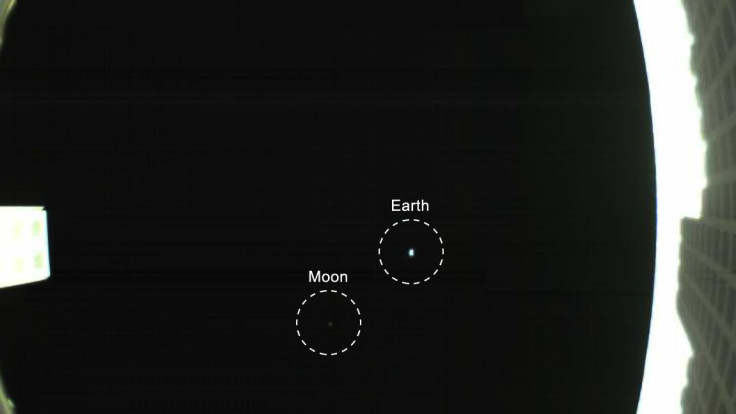Pale Blue Dot And White Companion: NASA's Mars-Bound CubeSat Captures Earth-Moon Duo

On May 5, NASA launched InSight Mars mission to understand the inner chemistry of the red planet. The lander lifted-off successfully and is en-route to its destination, but not many would know that it is not alone on this journey. The space agency also launched two tiny CubeSats with InSight, one of which has returned a glorious photograph of our planet Earth and its moon.
The image, taken by MarCO-B or Wall-E CubeSat, shows Earth as a faint blue dot and the moon, sitting a little far from it, as an even fainter mark. The satellite took the shot using its fisheye camera and beamed it back to Earth after the ground-control team properly unfolded its high-gain antenna on May 9. As the instrument is critical for transmitting mission-related data back to Earth, its deployment was verified with quick image-taking exercise.
NASA says the Earth-moon duo pictured in the shot is the CubeSat version of the iconic "pale blue dot" portrait of Earth taken from several billion miles away by Voyager 1 in 1990.
“Consider it our homage to Voyager," Andy Klesh, MarCO's chief engineer at NASA's Jet Propulsion Laboratory, said in a statement, which also included an annotated version of the photograph.
CubeSats were originally developed for experiment and research purposes, but now they form a critical part of major commercial missions, NASA said in a release. In this particular case, the pair of tiny CubeSats — MarCO-A & B — is the first one ever to embark on a journey to deep-space. Its launch broke the record for the farthest such satellite in space after crossing 621,371 miles from Earth on May 8.
“CubeSats have never gone this far into space before, so it's a big milestone,” Klesh added. “Both our CubeSats are healthy and functioning properly. We're looking forward to seeing them travel even farther."
That said, the agency plans to conduct more antenna deployment tests over coming weeks, but the main mission for the CubeSats is to follow the lander all the way to Mars and demonstrate the suitability of small spacecraft beyond in deep-space. If all goes as planned, the tiny satellites will relay radio data to Earth detailing InSight’s descent and landing on Mars.
Though the tiny satellites won’t be the primary source of communication with the lander, NASA hopes their performance could demonstrate a range of technologies which could enable future missions to carry their own data-transmission relay into deep-space. Plus, they might also demonstrate the working of antennas, radios, and propulsion systems that could enable future CubeSats to collect scientific data on distant worlds.
© Copyright IBTimes 2025. All rights reserved.




















